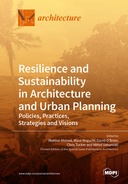Explore

Resilience and Sustainability in Architecture and Urban Planning: Policies, Practices, Strategies and Visions
0 Ungluers have
Faved this Work
Login to Fave
The production and development of the built environment relates strongly to the fields of architecture and urban planning. The built environment experiences severe impacts from disasters that have become more frequent and intense around the world due to climate change and other human actions, requiring research on architectural design and urban planning that contributes to resilience. On the other hand, the built environment itself causes environmental impacts through the consumption of energy, land-use change and pressure on ecosystems, among a variety of other factors. Thus, research-informed policies, practices, and strategies relating to the built environment are necessary, requiring innovative and forward-thinking visions for a resilient and sustainable future. The built environment is multifold, with its manifestation determined by economic levels, political systems, demography, and natural resources. Therefore, contextual approaches and solutions in architecture and urban planning are essential to produce a diverse range of research findings. This publication serves as a platform to assemble such recent and innovative research findings relating to resilience and sustainability in the architecture and urban planning fields, and through an open access mode, disseminate this knowledge widely at a time when the world is facing critical challenges posed by disasters and environmental transformation.
This book is included in DOAB.
Why read this book? Have your say.
You must be logged in to comment.
Rights Information
Are you the author or publisher of this work? If so, you can claim it as yours by registering as an Unglue.it rights holder.Downloads
This work has been downloaded 76 times via unglue.it ebook links.
- 76 - pdf (CC BY) at Unglue.it.
Keywords
- adaptation
- Architectural design
- Architecture
- Cappuccinelli Social Housing district
- Climate Change
- CMIP6
- Communication
- community infrastructure
- Construction industry
- construction projects
- COVID-19 Pandemic
- cyclones
- Design
- design thinking
- Disaster mitigation
- Disaster Recovery
- disaster-risk reduction
- Elemental
- Energy Efficiency
- energy efficiency improvement
- energy performance gap
- extreme precipitation
- First Nation communities
- Gandaki Province
- GIS
- health and safety
- incremental housing
- minimalism
- multi-hazard
- neighborhood evaluation
- occupant behavior
- Parameters
- PPGIS
- renovation works
- residential buildings
- resilience
- self-recovery
- shelter
- social housing
- Sri Lanka
- sustainability
- The arts
- thema EDItEUR::A The Arts
- thema EDItEUR::A The Arts::AM Architecture
- topological mapping
- Town Camps
- Trapani
- tsunami
- urban analysis
- urban evaluation
- urban planning
- Urban regeneration
- Urban renewal
- Vanuatu
- Villa Verde
Links
DOI: 10.3390/books978-3-0365-6418-0Editions

